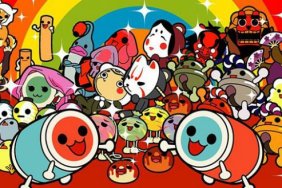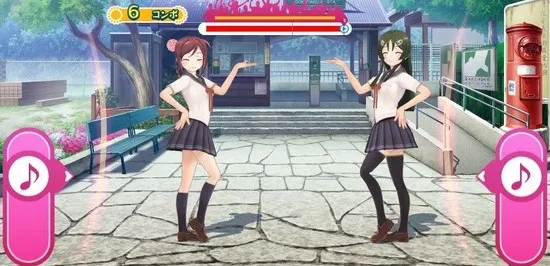
In Uta Kumi 575, two high school friends have dreams of making it big in the pop scene. You’ll help them do this by tapping the screen and rear touch pad in time with their music. Anime fans may recognize the name for its relation to mini-series Go! Go! 575, but one need not be familiar with the show to have fun with the game.
Azuki and Macha sing and dance, all the while key notes are coming from the left and right sides. Since this is a rhythm game, timely touches and a good musical ear are key. The videos don’t tend to be the hyper-flashy kind with shooting stars, neon swimming pools, and rockets to the moon here. The most pizazz you’ll usually see is a sweeping colorful backgrounds, which is just fine; these are just two regular school girls with big dreams. The choreography during each song is well done, albeit simple. It’s mostly the two of them doing their fairly basic dances — the kind you’d actually expect to see at a high school talent show (by people with talent). It has a certain special charm about it — a strength rather than a weakness. The girls are just putting up their own video camera and recording themselves reaching for their dreams, kind of like we all used to do before reality crushed us, right?
Play through songs, rack up points, and unlock more songs and story scenes, plus new content such as — of course — new outfits for your on-screen leading ladies. What I like is that even though these girls are cute as heck, they’re not oversexualized with skimpy costumes or suggestive dances.
The story is humorous and cute, with Macha and Azuki expressing themselves through song and dance and clinging to the old Japanese haiku format, meaning their songs rely heavily on lines of five, then seven, then five syllables, hence the 5-7-5 in the title.
In addition to hitting notes on time, you’ll need to quickly assign lyrics into the correct spots within the song.
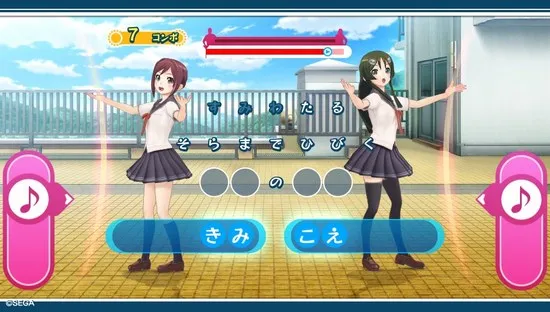
See that right there in the screen above? The left says “kimi” and the right says “koe.” That bottom line makes “Kimi no koe” or “your voice.” If you don’t know your shit well enough, you’ll be coming up short on your scores. Later versions of the songs naturally get harder, so instead of just picking from kimi and koe, you’ll have the “no” in there too once you hit that next level. As things progress, you’ll have to sort through more words than just two; you’ll also be thrown for a loop by fakeout lyrics. This coming in addition to notes being on different sides of the screen and requiring different sides of the Vita to be touched, you’re going to have your attention quite divided and won’t have much time to carefully consider the logic of your Japanese sentences. Therefore, this is not recommended for those with no Japanese knowledge.
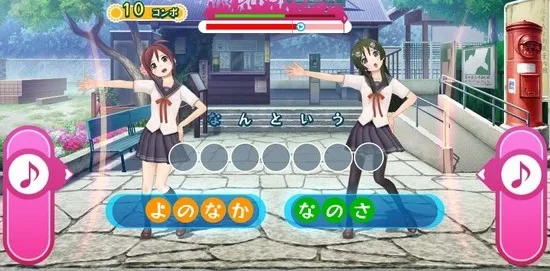
You should at least be able to read hiragana, and katakana, but even then, your lyrical choices will depend upon your ability to quickly decipher the meaning of a sentence. So to really master everything to the highest extent, you’ll need a pretty good level. Otherwise, you might feel like you’re okay with just shooting for dumb luck in the lyrical sections of each song.
But, if you don’t read any Japanese, there’s still a sort of safety net in place. If you make a lyrical mistake, you can see your flub on the post-song score sheet. So if you’re okay with not knowing the words but treating Japanese as some sort of hieroglyphics, there’s that route. It might be tough, but it’s doable. Stages can still be cleared in spite of messed up words. Better scores are awarded for correct answers, of course, but one can still scrape by on the strength of hitting the musical notes correctly.
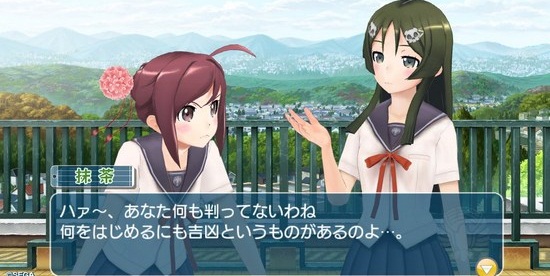
Since the vocals are done by vocaloid software, Azuki and Macha will actually sing your mistaken lyrics, which can be kinda funny.
Problems arise when trying to keep your eyes on both ends of the Vita screen simultaneously. Judging whether or not two notes are simultaneous or a microsecond apart can be unnecessarily tricky because of the playing field’s super-wide layout. Trying to watch when each notes come to the touch point is a rhythmic challenge, but splitting one’s eyes apart with a knife to watch the opposite ends of the screen in enough detail is tricky and painful, which is why I’ve only done it a few times.
Uta Kumi‘s controls are heavily touch-based. I love my Vita, but I don’t love the rear touch panel, especially when it’s my only option. In Uta Kumi 575, the back touch pad is used for blue notes while the front touch screen is used for pink notes. You’ve seen similar systems in music games before, as I immediately thought of Taiko Drum Master, the way red notes mean to hit the middle of the drum and blue notes mean to hit the rim — different colors, different parts of the instrument, and in this case, your Vita is the instrument.
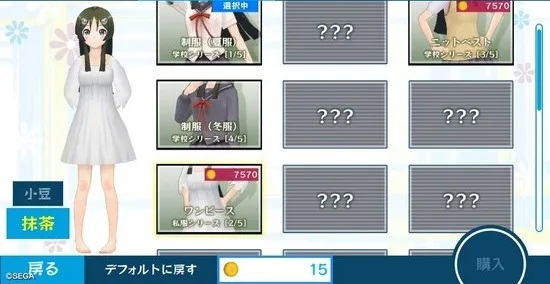
As a gameplay control scheme, touch-only is understandable, I guess, but it’s a strange decision to disable buttons even for tasks such as advancing dialogue. After a single line of conversation, the only thing a button can do is remove the text box. The screen must absolutely be touched in order to advance the characters’ discussion. There’s not even a menu setting that can be changed to allow continuous conversation play or anything that can get around it. You’ve got sit there tap, tap, tapping the screen after every single line, which is beyond stupid. Only one button out of six has any function, and we can’t assign one to be the “advance dialogue” button? That’s a weird decision. Apart from that, the UI is clean and menus are easy to navigate.
Uta Kumi 575 is an impressive, entertaining game overall. It’s not spectacular, but there are no big problems with it either. It’s definitely fun, especially in short bursts perfectly suiting a portable. The music is good, the girls are adorable, the animation all looks great, and most importantly the rhythm game itself delivers.
Review copy received via Play-Asia.com. Game available in standalone and limited edition.
(Post-review notes for importers. Read the PSLS guide to importing here.)
Despite the rhythm game calling for good Japanese vocabulary and knowledge of hiragana and katakana, this is a very importable game for any Vita owner. As the review mentions, you can still clear songs an unlock content if you mess up words. If you’re a high-level Japanese learner, the songs can be a great way to keep yourself sharp. If not, it’s actually no big deal. The menus are self explanatory, for the most part, and most importantly, the rhythm game is too. The story uses kanji and is available only in Japanese, but it’s fully voice acted and the girls wear their emotions on their sleeves; some will be satisfied with this, others of course will not, so consider this as well. There’s a demo on the Japanese PSN.
-
Azuki and Macha.
-
Gameplay uniquely fun.
-
Good, simple unlockable system.
-
Enjoyable soundtrack.
-
Charming videos and dance routines.
-
Girls are cute without being sexualized.
-
Lyrics add fun twist.
-
Respect the haiku.
-
Touchscreen only.
-
Mandatory back touch pad.
-
Song list and variety perhaps not as strong as some genre peers.






